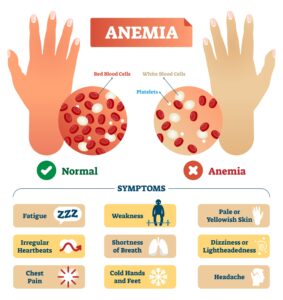Back to: Physical and Health Education JSS 2
Welcome to class!
In today’s class, we shall be talking about the Nature of asthma, and anemia as non communicable diseases. Please enjoy the class!
Nature of Asthma, and Anemia as Non- Communicable Diseases

By now, we must have know that Non-communicable diseases are silent warriors, lurking within, often chronic and complex. Today, we’ll delve into three Non-communicable disease that impact millions of people globally: asthma, anemia, and kwashiorkor. Buckle up, and let’s dissect their nature!
1. Asthma:
Imagine struggling to breathe, your chest tightening like a vice. That’s the daily reality for asthmatics. Asthma is a chronic inflammatory condition of the airways, causing hypersensitivity and narrowing in response to triggers like allergens, pollutants, or even exercise.
Symptoms includes, Wheezing, coughing, shortness of breath, chest tightness, and difficulty sleeping are the battle cries of asthma.
Counter measure: Inhalers containing bronchodilators and corticosteroids are the primary weapons, calming inflamed airways and easing breathing.
2. Anemia: The Red Blood Cell Disease

Picture your red blood cells, the oxygen-carrying warriors, feeling faint and sluggish. That’s anemia, a deficiency in red blood cells or hemoglobin, the oxygen-binding protein within. This leads to oxygen deprivation, impacting vital organs and causing:
Symptoms: Fatigue, weakness, pale skin, dizziness, breathlessness, and headaches are the distress signals of anemia.
Reinforcements: Iron supplements, vitamin B12, and folic acid replenish the troops, while treating underlying causes like blood loss or malnutrition strengthens the army.
3. Kwashiorkor: Protein Plunderers
Kwashiorkor, mainly affecting children in developing countries, is a severe form of protein malnutrition. When protein intake plummets, the body ransacks itself for fuel, causing:
Symptoms: Distended bellies, swollen limbs, thin hair, skin lesions, and apathy are the tragic hallmarks of kwashiorkor.
Nutritional Remedies: Therapeutic milk-based diets rich in protein and essential nutrients provide the cavalry charge, rebuilding bodies and restoring health.
Remember, prevention is key! Healthy lifestyles, balanced diets, and addressing environmental triggers can keep these Non-communicable disease at bay.
Early diagnosis and treatment are crucial for managing Non-communicable disease and minimizing their impact.
Support and empathy are vital for individuals living with Non-communicable disease, empowering them to thrive despite their challenges.
We have come to the end of today’s class. I hope you enjoyed the class!
In the next class, we shall be discussing the Causes of non-communicable diseases.
In case you require further assistance or have any questions, feel free to ask in the comment section below, and trust us to respond as soon as possible. Cheers!
Question Time:
Section A: Multiple Choice
- Which of the following is NOT a common symptom of asthma?
- a) Wheezing
- b) Fever
- c) Difficulty breathing
- d) Chest tightness
- Anemia is primarily caused by a deficiency in:
- a) Vitamin C
- b) Red blood cells
- c) Protein
- d) Calcium
- The term “kwashiorkor” originates from:
- a) Latin
- b) Greek
- c) African language (specify)
- d) Hindi
- Which intervention is MOST effective in preventing kwashiorkor?
- a) Vaccination
- b) Balanced diet
- c) Antibiotic treatment
- d) Clean water access
- Which statement about non-communicable diseases is FALSE?
- a) They are often chronic and long-term.
- b) They can be prevented or managed.
- c) They are contagious from person to person.
- d) They affect millions of people globally.
Section B:
- Describe the three main mechanisms by which asthma affects breathing. (10 marks)
- Explain the different types of anemia and their respective causes. (10 marks)
- Compare and contrast the symptoms and effects of kwashiorkor and marasmus. (10 marks)
- Discuss the importance of early diagnosis and treatment in managing non-communicable diseases. (10 marks)
- Evaluate the effectiveness of public health education campaigns in reducing the prevalence of Non-communicable disease. (10 marks)
